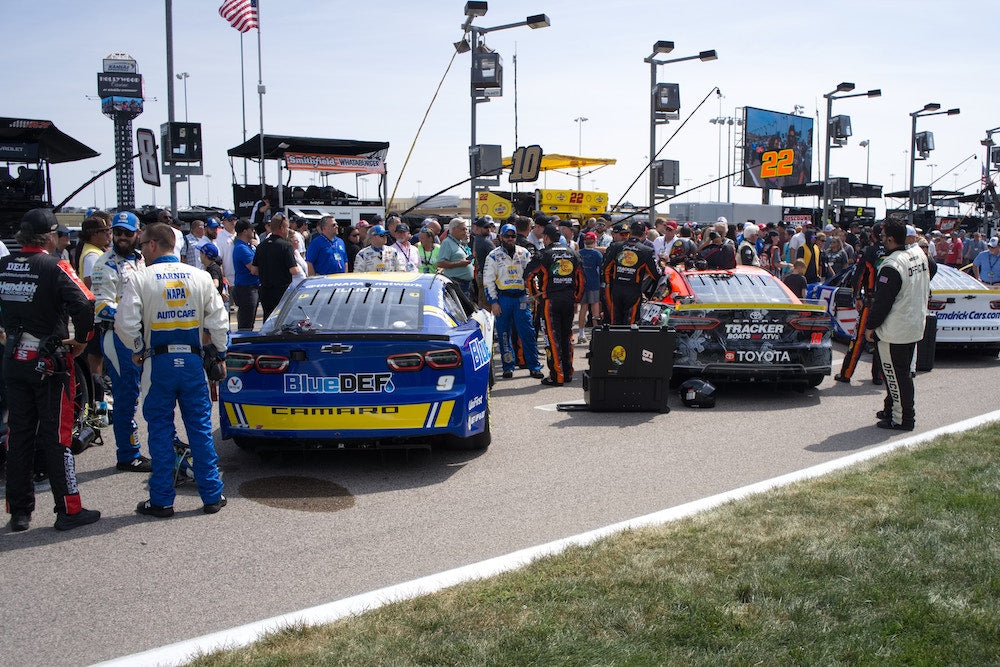Influence of Weather on NASCAR Race Strategies and Outcomes

When it comes to NASCAR racing, many factors come into play that can greatly impact the strategies and outcomes of races. One such factor that often goes overlooked is the weather. Weather conditions, such as rain, extreme heat, wind, and temperature, can have a significant influence on how races unfold. In this article, we will explore the impact of weather on NASCAR races, focusing on race strategies and outcomes.
Importance of Weather in NASCAR Races
Weather is an uncontrollable factor in racing, making it a crucial element to consider for teams and drivers. The ever-changing weather conditions can introduce a level of unpredictability to the races, challenging drivers to adapt their strategies on the fly. Additionally, weather conditions can directly affect the track conditions, tire grip, and car setups, further adding to the complexity of the race.
This article will delve into the various weather conditions that can affect NASCAR races, such as rain, extreme heat, wind, temperature, and cloud cover. We will explore how these conditions impact the race dynamics, strategies adopted by teams and drivers, and provide examples of races where weather played a significant role. Let's dive into the impact of weather on NASCAR races.
Impact of Weather
- Uncontrollable Factor in Racing: Weather is one of the few uncontrollable factors in racing. While teams and drivers can prepare their cars and strategies based on various factors, they cannot control or predict the weather conditions they will face on race day. This introduces an element of uncertainty and challenges teams and drivers to adapt their plans on the spot.
- Influence on Race Dynamics and Unpredictability: The weather has a direct impact on race dynamics and can make races more unpredictable. For example, rain can create a wet track, causing cars to lose grip and slide around. Extreme heat can lead to tire wear and changes in track conditions, affecting the performance of the cars. Wind can also pose challenges by affecting the handling of the cars. All these factors contribute to an unpredictable race where anything can happen.
- Examples of Weather Conditions: NASCAR races have seen various weather conditions throughout the years. Rain is perhaps the most well-known weather condition that impacts races. Races have been delayed or halted due to heavy rain, making the track unsafe for racing. Extreme heat is another weather condition that affects races, as it can lead to tire wear and changes in track conditions. Other factors such as wind, temperature, and cloud cover also play a role in influencing the outcome of races.
Rain: The Game-Changer
Rain can be a game-changer in NASCAR races. When rain falls on the track, it makes the surface wet and reduces the grip of the tires. This can lead to cars sliding and spinning out, making it difficult for drivers to maintain control. The wet track also affects the aerodynamics of the cars, as rain can disrupt the airflow over the body of the car, reducing downforce.
Delayed or Halted Races Due to Rain
In some cases, races have been delayed or even halted due to heavy rain. NASCAR has strict safety protocols in place to ensure the well-being of drivers, crews, and spectators. If the track becomes too wet and unsafe for racing, officials may decide to suspend the race until conditions improve. This can lead to further challenges for teams and drivers, as they need to adapt their strategies to the changing race conditions.
Strategies Adopted by Teams and Drivers in Wet Conditions
When rain falls during a race, teams and drivers need to quickly adapt their strategies to the wet conditions. Some teams may choose to switch to rain tires, which have a different tread pattern that provides better grip on wet surfaces. Others may adjust the suspension and setup of the car to optimize performance in the wet conditions. It becomes a delicate balance of finding the right strategy to maximize speed while maintaining control on the wet track.
Example of a Race Affected by Rain
One notable race that was greatly affected by rain is the 2008 AMP Energy 500 at Talladega Superspeedway. The race was initially delayed for several hours due to heavy rain. When the race finally started, rain continued to fall intermittently, creating a challenging race for the drivers. Strategies varied among teams, with some opting for rain tires and others sticking with slick tires. The changing weather conditions and wet track led to numerous caution periods and unpredictable racing. Ultimately, the race was shortened due to darkness, with Tony Stewart declared the winner.
Extreme Heat: The Challenge for Drivers and Crews
Extreme heat can have a significant impact on track conditions. As the temperature rises, the track surface becomes hotter, which affects the tire grip. The hotter the track, the less grip the tires have, making it more challenging for drivers to maintain control of their cars. The increased heat also causes the track surface to become more slippery, further adding to the difficulty for drivers.
Changes in Tire Grip and Wear
High temperatures can lead to changes in tire grip and wear. As the track temperature rises, tires tend to wear more quickly, reducing their overall performance. This means that drivers need to manage their tires carefully, as excessive wear can result in decreased speed and handling. Teams also need to adjust their pit strategies, ensuring that tires are changed at the right time to maintain optimal performance.
Adjustments in Pit Strategies and Car Setups
Extreme heat calls for adjustments in pit strategies and car setups. Teams may opt for different tire compounds that are better suited for the hot track conditions. They may also make changes to the suspension and setup of the car to improve handling and tire performance. Pit stops become crucial, as teams need to efficiently change tires and make any necessary adjustments to keep the car competitive in the extreme heat.
Example of a Race Affected by Extreme Heat
The 2017 Coca-Cola 600 at Charlotte Motor Speedway is a race that was heavily impacted by extreme heat. With temperatures soaring above 90 degrees Fahrenheit, the track conditions became challenging for drivers. Tire wear was a significant concern, as the hot track caused increased wear and reduced grip. Teams had to carefully manage their tire strategy, making timely pit stops to change tires and ensure optimal performance. Martin Truex Jr. emerged as the winner, showcasing the importance of tire management in extreme heat.
Other Weather Factors
Temperature and Its Impact on Aerodynamics
Temperature plays a crucial role in aerodynamics, which directly affects the performance of the cars. As the temperature changes, the density of the air also changes, affecting the way air flows over the car's body. Cooler temperatures result in denser air, providing more downforce and grip. On the other hand, hotter temperatures lead to thinner air, reducing downforce and grip. Teams need to consider the temperature when setting up their cars, making adjustments to maximize performance.
Wind and Its Effect on Car Handling
Wind can have a significant impact on car handling. A strong headwind can reduce the overall speed of the cars, as it creates resistance and affects aerodynamics. Crosswinds can also pose challenges, as they can push the cars towards the outside of the track or cause them to become unstable. Drivers need to be aware of the wind conditions and make the necessary adjustments to maintain control of their cars.
Cloud Cover and Its Influence on Track Temperature
Cloud cover can affect the track temperature, which in turn impacts the grip and performance of the tires. When the sun is blocked by clouds, the track temperature tends to be lower, resulting in more grip. This can lead to faster lap times and more aggressive racing. Conversely, when the sun is shining directly on the track, the temperature rises, reducing grip and making it more difficult for drivers to push their cars to the limit.
Examples of Races Impacted by These Weather Factors
One race that was heavily influenced by temperature is the 2005 UAW-GM Quality 500 at Charlotte Motor Speedway. The race took place in cool temperatures, which resulted in increased grip and faster lap times. Drivers were able to push their cars to the limit, resulting in intense racing and several lead changes. Jimmie Johnson emerged as the winner, showcasing the impact of temperature on race dynamics.
Challenges of Dealing with Weather
Unpredictability of Weather Conditions
One of the biggest challenges of dealing with weather in NASCAR races is its unpredictability. Weather forecasts can provide some guidance, but they are not always accurate, especially when it comes to localized weather patterns. Teams and drivers need to be prepared for any weather conditions that may arise on race day and have contingency plans in place to adapt their strategies accordingly.
Safety Concerns for Drivers and Spectators
Weather conditions can pose safety concerns for both drivers and spectators. Rain can make the track slippery and increase the risk of accidents. Extreme heat can lead to heat exhaustion and dehydration for drivers and pit crews. Strong winds can also pose a safety risk, especially at high speeds. NASCAR takes safety very seriously and has protocols in place to ensure the well-being of everyone involved in the race.
Impact on Race Strategy and Outcomes
Weather conditions can have a significant impact on race strategy and ultimately determine the outcome of a race. Teams and drivers need to make split-second decisions based on the changing weather conditions to optimize their performance. Pit strategies, tire choices, and car setups all need to be adjusted to adapt to the weather. The team that can effectively navigate the challenges posed by weather conditions often has an advantage and a higher chance of success.
Example of a Race Affected by Unpredictable Weather
The 2015 Quicken Loans Race for Heroes 500 at Phoenix International Raceway is a race that was greatly affected by unpredictable weather. Rain showers moved in and out throughout the race, forcing teams and drivers to constantly adjust their strategies. Some teams chose to pit for rain tires, while others opted to stay out on slick tires. The changing weather conditions led to multiple caution periods and added another layer of complexity to an already intense race. Dale Earnhardt Jr. emerged as the winner, showcasing his ability to adapt to the unpredictable weather conditions.
Beyond the Basics
Influence on Aerodynamics and Tire Selection
Weather conditions can have a significant influence on aerodynamics and tire selection. Cooler temperatures result in denser air, providing more downforce and grip. This can lead to faster lap times and more aggressive racing. On the other hand, hotter temperatures reduce downforce and grip, requiring teams to adjust their setups and tire choices accordingly. Finding the right balance between grip and speed is crucial in maximizing performance.
Impact on Tire Performance
Weather conditions directly impact tire performance. Rain tires have a different tread pattern that provides better grip on wet surfaces, allowing drivers to maintain control. In extreme heat, tire wear increases, reducing overall performance and grip. Teams need to carefully manage their tire strategy to ensure optimal performance throughout the race. The ability to understand and adapt to the changing tire performance based on weather conditions is a crucial skill for teams and drivers.
Importance of Track Temperature and Wind Speed
Track temperature and wind speed are two factors that significantly impact the performance of the cars. Cooler track temperatures result in increased grip, allowing drivers to push their cars to the limit. Wind speed affects car handling, as strong headwinds can reduce speed and affect aerodynamics. Teams need to closely monitor these factors and make the necessary adjustments to optimize performance.
Example of a Race Where These Factors Played a Crucial Role
The 2018 AAA Texas 500 at Texas Motor Speedway is a race where track temperature and wind speed played a crucial role. The race took place in cool temperatures, which resulted in increased grip and faster lap times. The wind was also a factor, with strong gusts affecting the handling of the cars. Teams had to make adjustments to their setups to maximize performance in these conditions. Kevin Harvick emerged as the winner, showcasing the importance of understanding and adapting to these weather factors.
Conclusion
Weather plays a significant role in NASCAR races, impacting race strategies and outcomes. Rain can create a wet track and introduce unpredictability to the race. Extreme heat can affect tire grip and wear, challenging teams to manage their tires effectively. Other weather factors such as temperature, wind, and cloud cover also influence race dynamics. Dealing with weather in NASCAR races presents challenges due to its unpredictability and safety concerns. Understanding the intricacies of weather, such as its influence on aerodynamics and tire performance, is crucial for success in NASCAR races.


